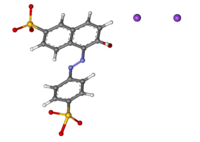FD&C Yellow 6
 |
|
 |
|
| Names | |
|---|---|
|
IUPAC name
Disodium 6-hydroxy-5-[(4-sulfophenyl)azo]-2-naphthalenesulfonate
|
|
| Other names
Orange Yellow S; FD&C Yellow 6; C.I. 15985; E110
|
|
| Identifiers | |
|
3D model (JSmol)
|
|
| ChemSpider | |
| ECHA InfoCard | 100.018.629 |
| E number | E110 (colours) |
| KEGG | |
|
PubChem CID
|
|
| UNII | |
|
|
|
|
| Properties | |
| C16H10N2Na2O7S2 | |
| Molar mass | 452.36 g·mol−1 |
| Melting point | 300 °C (572 °F; 573 K) |
| Hazards | |
| NFPA 704 | |
|
Except where otherwise noted, data are given for materials in their standard state (at 25 °C [77 °F], 100 kPa).
|
|
|
|
|
| Infobox references | |
Sunset Yellow FCF (also known as Orange Yellow S, or C.I. 15985) is a petroleum-derived orange azo dye with a pH dependent maximum absorption at about 480 nm at pH 1 and 443 nm at pH 13 with a shoulder at 500 nm. When added to foods sold in the US it is known as FD&C Yellow 6; when sold in Europe, it is denoted by E Number E110.
Sunset Yellow is used in food, cosmetics, and drugs. For example, it is used in candy, desserts, snacks, sauces, and preserved fruits.
Sunset Yellow is often used in conjunction with E123, amaranth, to produce a brown colouring in both chocolates and caramel.
The acceptable daily intake (ADI) is 0–4 mg/kg under both EU and WHO/FAO guidelines.
Sunset Yellow FCF has no carcinogenicity, genotoxicity, or developmental toxicity in the amounts at which it is used.
It has been claimed since the late 1970s under the advocacy of Benjamin Feingold that Sunset Yellow FCC causes food intolerance and ADHD-like behavior in children but there is no scientific evidence to support these broad claims. It is possible that certain food coloring may act as a trigger in those who are genetically predisposed, but the evidence is weak.
Sunset Yellow FCF is banned or restricted as a food additive in Norway, Finland and Sweden.
In 2008, the Food Standards Agency of the UK called for food manufacturers to voluntarily stop using six food additive colours, Tartrazine, Allura Red, Ponceau 4R, Quinoline Yellow WS, Sunset Yellow and Carmoisine (dubbed the "Southampton 6") by 2009, and provided a document to assist in replacing the colors with other colors.
...
Wikipedia

